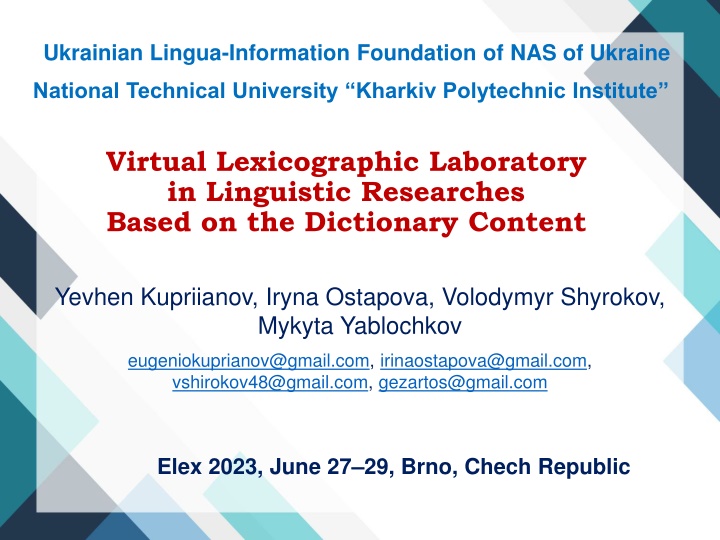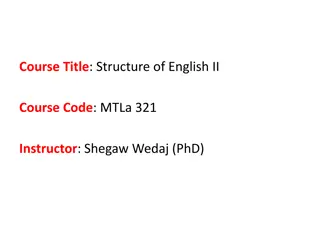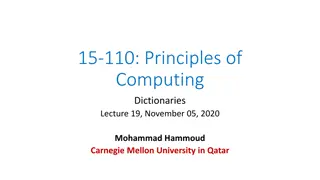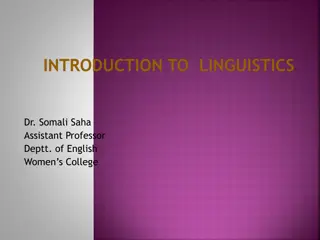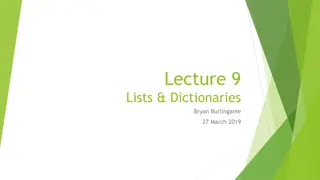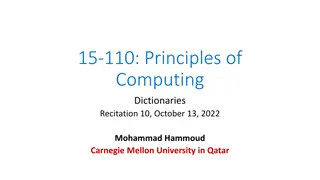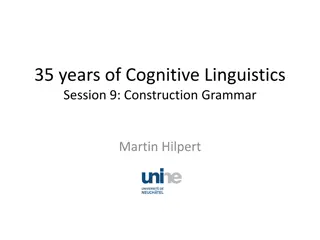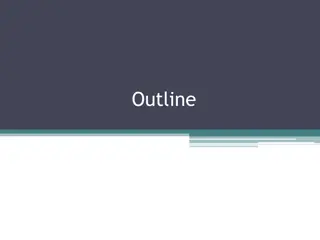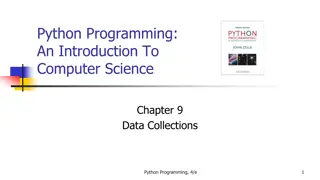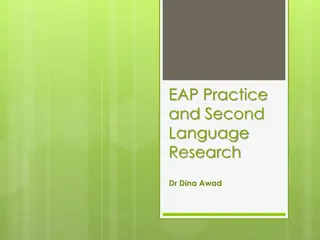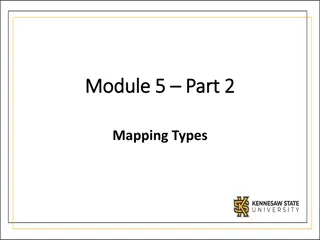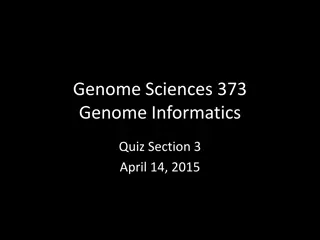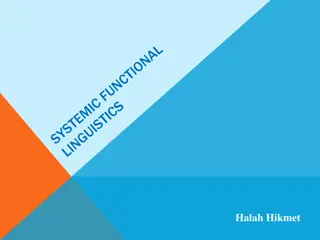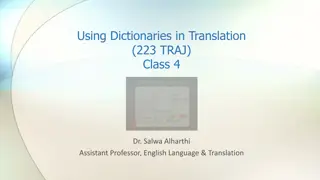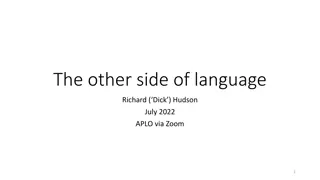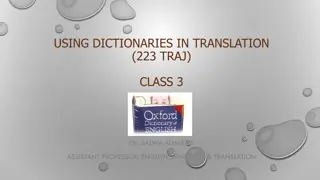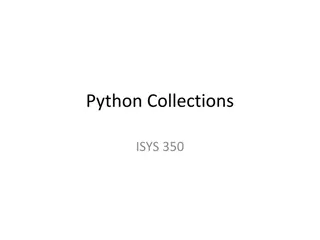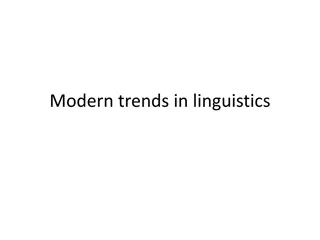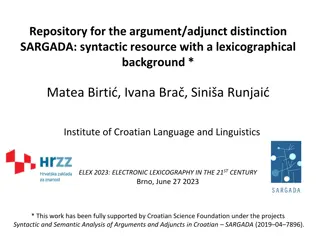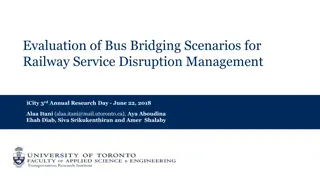Computer Lexicography: Bridging Linguistics and Technology in Digital Dictionaries.
Computer lexicography explores the intersection of linguistics and technology to develop effective systems for creating and utilizing lexical resources in digital environments. The shift from traditional paper dictionaries to digital formats like the Spanish Language Dictionary (DLE 23) signifies a growing research interest in leveraging digital tools for linguistic analysis and translation purposes.
Download Presentation

Please find below an Image/Link to download the presentation.
The content on the website is provided AS IS for your information and personal use only. It may not be sold, licensed, or shared on other websites without obtaining consent from the author.If you encounter any issues during the download, it is possible that the publisher has removed the file from their server.
You are allowed to download the files provided on this website for personal or commercial use, subject to the condition that they are used lawfully. All files are the property of their respective owners.
The content on the website is provided AS IS for your information and personal use only. It may not be sold, licensed, or shared on other websites without obtaining consent from the author.
E N D
Presentation Transcript
Ukrainian Lingua-Information Foundation of NAS of Ukraine National Technical University Kharkiv Polytechnic Institute Virtual Lexicographic Laboratory in Linguistic Researches Based on the Dictionary Content Yevhen Kupriianov, Iryna Ostapova, Volodymyr Shyrokov, Mykyta Yablochkov eugeniokuprianov@gmail.com, irinaostapova@gmail.com, vshirokov48@gmail.com, gezartos@gmail.com Elex 2023, June 27 29, Brno, Chech Republic
Introduction Computer lexicography appeared intersection of linguistics and computer science. Research area that studies the problems of applying computer science methods for building a wide range of systems to create, support and work with lexicographic resources in digital environment. A branch of computer industry that develops the systems based on lexicographic description as an efficient way to obtain and transfer knowledge. 2
Introduction Some well-known dictionaries that have been traditionally made in paper are gradually changing to digital format. Explanatory dictionary is considered as a comprehensive source of information to be used for language researches. Research potential of dictionary is fully developed in digital environment. This sets a problem of providing dictionaries with appropriate tools. 3
Spanish Language dictionary (DLE 23) For the purposes of our research we have selected Spanish Language Dictionary entitled Diccionario de la lengua espa ola. 23 edici n (shortly DLE 23), which has been published by the Academia Real Espa ola (Spanish Royal Academy). The DLE 23 is the most comprehensive and representative explanatory dictionary of the Spanish language. The 23rd edition was published in October 2014. The year later DLE 23 was made available on CD-ROM and then online at www.dle.rae.es. Now the Academy is working on a 24th edition, which is supposed to be digital only 4
Introduction Title: Diccionario de la lengua espa ola. Edition: 23. Publisher: Real Academia Espa ola. Year: 2014. Volume: 93111. The task of our project is to design and implement linguistic tools for analyzing digital dictionary text. 5
Spanish Language dictionary (DLE 23) Our interest in DLE 23 is arisen by the following reasons: 1) international status of the Spanish language; 2) credibility and academic status of the dictionary; 3) school of lexicography. In addition, the dictionary in question is of interest to translation lexicography while creating translation systems: Spanish-Ukrainian and Ukrainian-Spanish. Another and also important reason of choosing DLE 23 is the availability of its digital version that supports HTML5 format. This fact guarantees the authenticity of the dictionary text and allows us to focus our attention on the structure of dictionary entry. 6
Introduction Successful implementation of this project, would be a great advance in: - translation lexicography due to reliable language material; - linguistics to study the principles of Spanish vocabulary presentation; - developing new approaches to designing explanatory dictionary interfaces; 7
Method and technology As a theoretical basis, we use the theory of lexicographic systems developed and proposed by the Ukrainian Academician Volodymyr Shyrokov. Lexicographic system (L-system) is a special informational (semiotic and semantic) system, in which a lexicographic effect (or a combination of lexicographic effects) is induced. We consider the dictionary as a lexicographic system of special type with a set of language units and a set of their descriptions. 8
Method and technology {? ? ,? ? ? ,?,? ? ,???[? ? ? ]}) D - dictionary; I(D) = {xi} set of language units; V(I(D)) = {V(xi)} set of lexicographical descriptions; set of structures on V(I(D)); [ ] separate structure generated by the operator on ; Red[V(I(D))] mechanism of recursive reduction. 9
Method and technology L-system architecture ANSI/ 3/SPARK Internal level Conceptual level External level One of the main aspects in the definition of an L-system as an information system of a special type is the concept of its architecture. 10
Method and technology Ukrainian Lingua-Information Fund has developed the software systems to support creating, maintaining and functioning of the dictionaries in digital environment named virtual lexicographic laboratories (VLL). 11
VLL for Spanish language dictionary Developing VLL Building up conceptual model Development of database Making a Web application Choosing database type Entry text analysis Entry structure determination 12
VLL for Spanish language dictionary The project of VLL DLE 23 is planned to be implemented in two stages: 1) creating a shortened version of VLL with minimum interface elements to test some technological solutions and 2) developing fully functional application with expanded interface. Currently VLL DLE 23 is at end of the first stage and it demonstrates more capabilities for working with the dictionary in digital environment than the original online version of DLE 23. 13
VLL for Spanish language dictionary The current version of the VLL DLE 23 can be accessed at https://svc2.ulif.org.ua/Dics/ResIntSpanish 14
VLL for Spanish language dictionary The interface of VLL allows the following modes to work with the dictionary: Headword List with search filters like in original Spanish dictionary online ( contains , startswith , ends with etc.). Entry Profile for making a sample of entries which satisfy the parameters of entry elements. Full-Text Search to select entries by specific meta- language elements of dictionary text. 15
Main window of DLL 23 Main window of DLL 23 16
we have given a string of one character ( we have given a string of one character (- -) ) which should be at the end which should be at the end 18
Entry Profile Entry Profile The mode is activated by clicking the menu Sample after which the dialog box appears. The dialog box has two tabs Headword and Entry . In first the user can choose headword parameters by which the entries are to be selected: 1. Headword variants: lemma, masculine, feminine, regional variant, not defined. 2. Headword structure: word, collocation, morpheme, not defined. 3. Headword type: foreign word, abbreviation, acronym, not defined. 4. Homonymy: yes ( 1) / no (0). The second tab is intended for selecting the entries which correspond to definition / collocation parameters: 5. Number of definitions: numerical value and additional options (>, , = , <). 6. Number of collocations Noun + Adj. : numerical value and additional options (>, , = , <). 7. Number of collocations of other types: numerical value and additional options (>, , = , <). 8. Number of cross-reference: numerical value and additional options (>, , = , <). 19
Lets make a sample of the words borrowed from other languages. As a result, the laboratory selected 313 units from DLE 23 22
We may want to know the availability of monosemantic words among those selected in the example. The total of the words in the sample is 231. 23
Future works In final version of VLL DLE 23 the structural profile of dictionary entry will be determined by all the structural elements of the conceptual model. The user will be able to select the entries by indicating obligatory presence or absence of a structural element. Additionally the user will have the possibility of specifying specific content of the structural elements. 25
